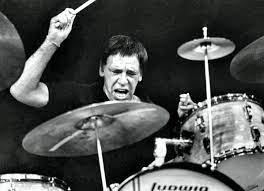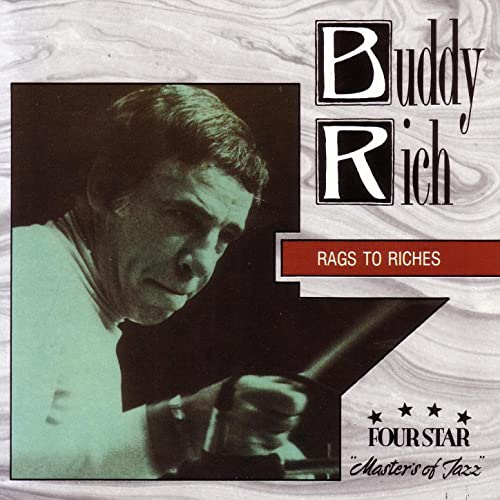
Rich, Buddy
Bernard “Buddy” Rich (September 30, 1917 – April 2, 1987) was an American jazz drummer and bandleader. He is considered one of the most influential drummers of all time.
Rich was born and raised in Brooklyn, New York. He discovered his affinity for jazz music at a young age and began drumming at the age of 2. He began playing jazz in 1937, working with acts such as Tommy Dorsey, Count Basie, and Harry James. From 1942 to 1944, Rich served in the U.S. Marines. From 1945 to 1948, he led the Buddy Rich Orchestra. In 1966, he recorded a big-band style arrangement of songs from West Side Story. He found lasting success in 1966 with the formation of the Buddy Rich Big Band, also billed as the Buddy Rich Band and The Big Band Machine.
Rich was known for his virtuoso technique, power, and speed. He was an advocate of the traditional grip, though he occasionally used match grip when playing the toms. Despite his commercial success and musical talent, Rich never learned how to read sheet music, preferring to listen to drum parts and play them from memory.
His jazz career began in 1937 with clarinetist Joe Marsala. He became a member of big bands led by Bunny Berigan and Artie Shaw. When he was home from touring with Shaw, he gave drum lessons to a 14-year-old Mel Brooks for six months. At 21, he participated in his first major recording with the Vic Schoen Orchestra who backed the Andrews Sisters.
In 1942, Rich left the Dorsey band to join United States Marine Corps, in which he served as a judo instructor and never saw combat. He was discharged in 1944 for medical reasons. After leaving the Marines, he returned to the Dorsey band. In 1946, with financial support from Frank Sinatra, he formed a band and continued to lead bands intermittently until the early 1950s.
Following the war, Rich formed his own big band which often played at the Apollo Theater and featured backing vocals from Frank Sinatra.
In addition to playing with Tommy Dorsey (1939–42, 1945, 1954–55), Rich played with Benny Carter (1942), Harry James (1953–56–62, 1964, 1965), Les Brown, Charlie Ventura, Jazz at the Philharmonic, and Charlie Parker (Bird and Diz, 1950).
In 1955, Gene Krupa and Buddy Rich recorded the collaboration album titled, “Krupa and Rich”, which featured the song “Bernie’s Tune”, where they traded drum solos for a total of six minutes.
From 1966 until his death, he led successful big bands in an era when their popularity had waned. He continued to play clubs but stated in interviews that the majority of his band’s performances were at high schools, colleges, and universities rather than clubs. He was a session drummer for many recordings, where his playing was often less prominent than in his big-band performances. Especially notable were sessions for Ella Fitzgerald and Louis Armstrong, and the Oscar Peterson trio with bassist Ray Brown and guitarist Herb Ellis. In 1968, Rich collaborated with the Indian tabla player Ustad Alla Rakha on the album Rich à la Rakha.
He performed a big-band arrangement of a medley from West Side Story that was released on the 1966 album Swingin’ New Big Band. The “West Side Story Medley”, arranged by Bill Reddie, highlighted Rich’s ability to blend his drumming into the band. Rich received the West Side Story arrangement of Leonard Bernstein‘s melodies from the musical in the mid-1960s; he found the music quite challenging and it took him almost a month of constant rehearsal to perfect. It later became a staple of his live performances. A six-minute performance of “Prologue/Jet Song” from the suite, performed during Frank Sinatra’s portion of the Concert for the Americas on August 20, 1982, is on the DVD “Frank Sinatra: Concert for the Americas”. In 2002, a DVD was released called The Lost West Side Story Tapes that captured a 1985 performance of this along with other numbers.
A live recording of the “Channel One Suite” is on the album Mercy, Mercy recorded at Caesars Palace in 1968. The album was acclaimed as the “finest all-round recording by Buddy Rich’s big band”.
Rich toured and performed until the end of his life. In early March 1987, he was touring in New York when he was hospitalized after suffering a paralysis on his left side that physicians believed had been caused by a stroke. He was transferred to California to UCLA Medical Center in Los Angeles for tests, where doctors discovered and removed a brain tumor on March 16. He was discharged a week later, but continued to receive daily chemotherapy treatments at the hospital. On April 2, 1987, he died of unexpected respiratory and cardiac failure after a treatment related to the malignant brain tumor. His wife Marie and daughter Cathy buried him in Westwood Village Memorial Park Cemetery in Los Angeles. He was 69.
